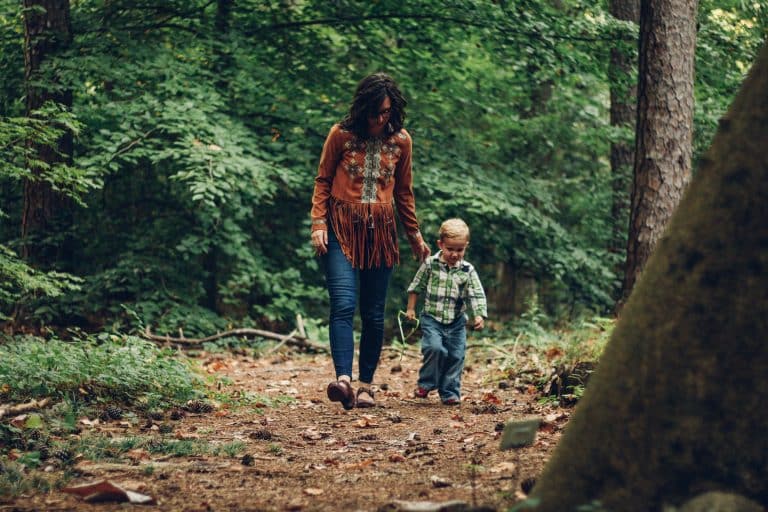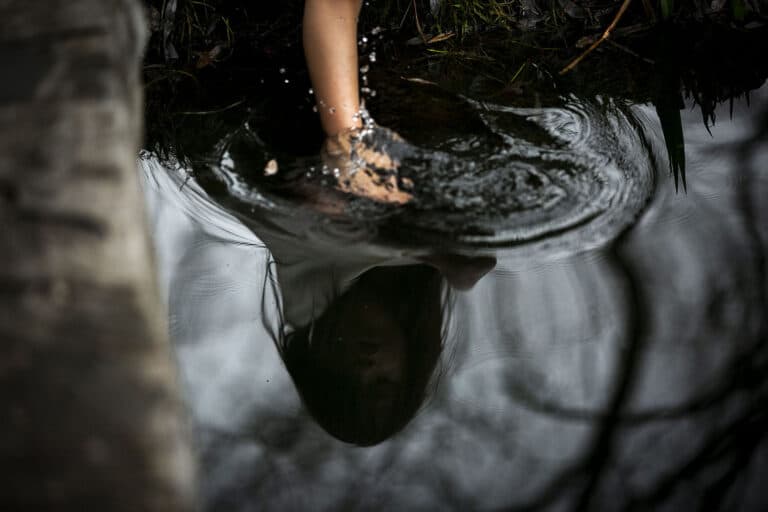
Image by Connor Dwyer, © All Rights Reserved.
A Slow and Steady Surrender
I got married when I was 19 years old to a young man who loved to climb rocks and counted the mysteries constantly unfolding in the world around him. After working in post-war Bosnia and Uganda, he settled into a season of carpentry as he studied rocks and the rivers, taking daily adventures where he came to know the presence of God in a grounded, sacred way, a slow and steady surrender to his own soul and the soul of the world.
As I watched the way he interacted with creation, something in me began to shift. Growing up a citizen of the Potawatomi Nation on Indian Territory and in New Mexico as a child, I walked barefoot on the dirt and watched my siblings and cousins climb the trees on my Grandma Avis’s farm. We picked pecans from my Grandmother Pauline’s trees that stood right beside the bright green awning covering the back porch. We spent time with stray cats and picked blackberries wherever we could find them.
Our sanctuary was the outdoors, but over time, I lost that magic. I stopped hearing the voices of a created world and instead heard voices of rules and lessons on how to be productive instead of imaginative. I lost myself.
Over the course of our marriage, and after we had children, I felt myself transforming from one life season to the next. I began remembering, surrendering to the ways I once lived, the way I once viewed the world as a thing of marvel that must be explored in order for people to be fully alive. I began surrendering to the idea that I don’t always have to live afraid.
There is something called blood memory, this marvel that you have a DNA connection to your ancestors that calls you back to your identity throughout your life. I found myself longing for a connection to the Potawatomi ways that seemed to be calling me back to childhood memories and back to a place of belonging.
We live in Atlanta, and when our family walks the trails outside our city, we find trees and rocks, rivers and mud puddles that invite us into the sanctuary of a beautifully created world. As taught by my Potawatomi ancestors, the world is alive, speaking to us constantly, if we’d only recognize that we are small, that we have something to learn if we tilt our ears downward to listen.
One day a few years ago, we drove 40 minutes outside Atlanta to hike at a place called Sweetwater Creek. While we walked, I nursed my one-year-old son. In that space, my ancestors came flooding into my memory — women who walked the Trail of Death, forced assimilation from the Great Lakes region of the United States into Kansas and later, Oklahoma, where my family lived.
It was a slow and steady unfolding, an invitation that seemed to be waiting there for me.
Every step I took in that moment brought me closer, both to their voices and to the voices of the dirt, the trees, the grass, a place that held memories not of my tribe, but of the Muskogee Creek people who were driven off this land in their own experience with forced assimilation. That blood memory continues to pulse through my veins — memories, stories, language seeping into my everyday experiences.
The trees and rocks, the water and grass, they all know the stories of the people. They know history, they’ve watched it unfold all around them. Even the garden in our front yard, the old bricks that are placed right outside our front door, hold a story that waits to be heard.
As we walked on that path, I realized that I am not at the center of the universe, but a humble learner in it. I saw things I’d never seen before — that God could indeed speak to me through the trees and the birds, through dragonflies that dance near the water source, their dance telling a centuries-old tale.
History is meant to speak to us long after the people who once lived are gone; and I have a responsibility to tend to the earth in a new and sacred way, step after step leading me to remember who I am and the responsibility I have to prepare my own children for who they will one day become after I am gone.
When we visit the river, we often take our kayak, and sometimes we go just to swim, just to splash and dig for rocks and shells in the sand.
As I watch my four- and six-year-old play in the water, I learn again for myself. I learn that the river slowly carries pebble after pebble over the rocks at the river’s floor, years and years of slow and steady wear to make the rocks smooth and still at the water’s edge.
This is what it is like to learn the ways of God, to learn the ways of the world, the ways of mystery. It is beyond religion, beyond theology, beyond the dogmatic things we were taught when we were young.
It is a slow and steady surrender to the current that we often don’t understand.
It is a slow and steady surrender to the mystery of God, who uses the everyday experiences of our lives to make our ragged edges a little smoother.
It’s that same kind of surrender when I sit in my garden and dig up weeds, best done crouched down on my knees, face so near the dirt I can smell it. It is painful, this long and hard work of weeding, just like the long, hard work of a river rock becoming smooth over the years.
To rest in the quiet of a current, in the quiet of work, I am simply taught to be, by the ways of the water, by the flowing and steady presence of God. Surrender is meant to take time, like all that time I spent watching my husband speak to rock faces and river currents. I didn’t know it then, but he was surrendering, and the world was surrendering, too.
And if we are wise, we will listen.
We will move as the current moves and rest when the waves tell us to sit still.
If we are wise, we will grow into this unknowing journey, into a deep trust in that current.
And when our children ask us why the river rocks are so smooth, or why it takes so much work to weed a tiny garden, maybe we’ll tell them that we are like those rocks, that our tired parts are like those weeds, that it is simply our time to watch, learn, and remember that we, too, are being shaped daily in this benevolently created world.

